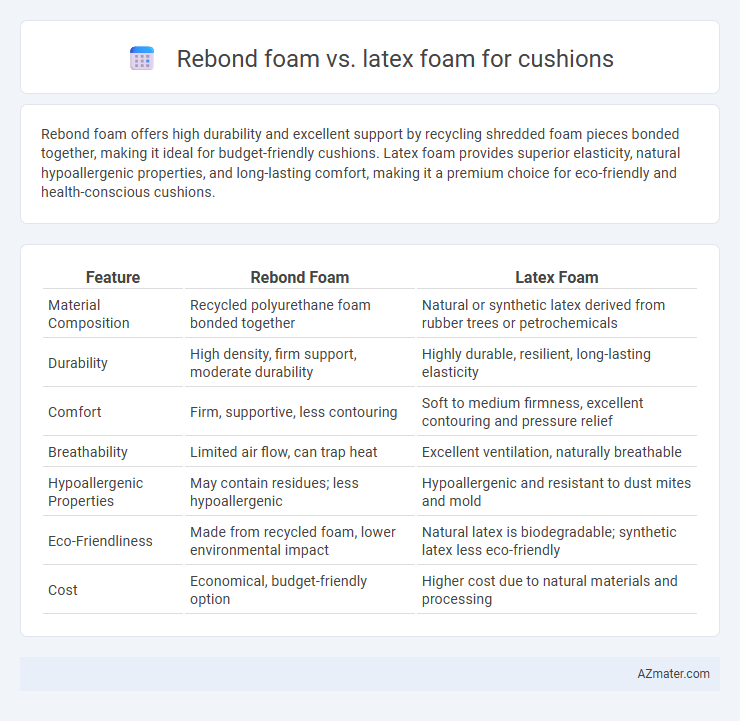Rebond foam offers high durability and excellent support by recycling shredded foam pieces bonded together, making it ideal for budget-friendly cushions. Latex foam provides superior elasticity, natural hypoallergenic properties, and long-lasting comfort, making it a premium choice for eco-friendly and health-conscious cushions.
Table of Comparison
| Feature | Rebond Foam | Latex Foam |
|---|---|---|
| Material Composition | Recycled polyurethane foam bonded together | Natural or synthetic latex derived from rubber trees or petrochemicals |
| Durability | High density, firm support, moderate durability | Highly durable, resilient, long-lasting elasticity |
| Comfort | Firm, supportive, less contouring | Soft to medium firmness, excellent contouring and pressure relief |
| Breathability | Limited air flow, can trap heat | Excellent ventilation, naturally breathable |
| Hypoallergenic Properties | May contain residues; less hypoallergenic | Hypoallergenic and resistant to dust mites and mold |
| Eco-Friendliness | Made from recycled foam, lower environmental impact | Natural latex is biodegradable; synthetic latex less eco-friendly |
| Cost | Economical, budget-friendly option | Higher cost due to natural materials and processing |
Introduction to Cushion Foam Types
Rebond foam, made from shredded and reprocessed polyurethane, offers high density and durability ideal for heavy-use cushions, while latex foam, derived naturally from rubber tree sap, provides superior elasticity and breathability for enhanced comfort and support. Rebond foam's firm structure resists compression set, making it suitable for seating that requires long-lasting resilience, whereas latex foam's hypoallergenic and antimicrobial properties cater to users seeking a healthier cushioning option. Choosing between rebond and latex foam depends on application needs such as comfort preference, durability requirements, and environmental considerations.
What is Rebond Foam?
Rebond foam is a type of cushioning material made by bonding shredded foam scraps together using adhesive and heat, resulting in a dense, durable, and firm foam block often used in high-impact seating and mattresses. It offers excellent support and resilience compared to natural latex foam, which is derived from rubber tree sap and prized for its elasticity, breathability, and hypoallergenic properties. Rebond foam is ideal for heavy-duty applications requiring durability and support, while latex foam excels in comfort and pressure relief.
What is Latex Foam?
Latex foam is a natural or synthetic material derived from rubber tree sap, known for its durability, resilience, and excellent support in cushions. It provides superior pressure relief and breathability compared to rebond foam, which is made from shredded polyurethane foam bonded together. The natural elasticity and hypoallergenic properties of latex foam make it an ideal choice for long-lasting, comfortable, and environmentally friendly cushioning solutions.
Comfort and Support Comparison
Rebond foam offers firm support with high density, making it suitable for durable cushions that maintain shape under heavy use, while latex foam provides superior comfort with its natural resilience and pressure-relieving properties, adapting better to body contours. Latex foam is generally more breathable and hypoallergenic, enhancing overall comfort by reducing heat retention and allergy risks, whereas rebond foam tends to be less breathable but excels in providing consistent support over time. Choosing between the two depends on the desired balance of long-lasting firmness and soft, adaptive comfort in cushion applications.
Durability and Longevity
Rebond foam offers high durability due to its dense composition made from recycled polyurethane fragments bonded together, making it resistant to wear and compression over time. Latex foam, derived from natural or synthetic latex, provides exceptional resilience and maintains its shape longer because of its inherent elasticity and resistance to sagging. When assessing longevity, latex foam generally outperforms rebond foam by retaining comfort and structural integrity for many years under consistent use.
Health and Allergy Considerations
Rebond foam, made from recycled polyurethane, often contains chemical residues and off-gassing compounds that may trigger allergies or respiratory issues in sensitive individuals. Latex foam, derived from natural rubber, offers hypoallergenic properties, resisting dust mites, mold, and bacteria, making it a preferred option for allergy sufferers and those with asthma. Choosing latex foam cushions can promote better indoor air quality and reduce the risk of allergic reactions compared to synthetic rebond foam alternatives.
Eco-Friendliness and Sustainability
Rebond foam, made from recycled scrap foam bonded together, offers a sustainable option by repurposing waste material, significantly reducing landfill impact. Latex foam, especially natural latex, derives from rubber tree sap, providing a biodegradable and renewable resource with minimal environmental footprint. Both materials support eco-friendly cushioning, but natural latex ranks higher in sustainability due to its renewable origins and biodegradability.
Cost Comparison: Rebond vs Latex Foam
Rebond foam typically costs significantly less than latex foam, making it a more budget-friendly option for cushions. While rebond foam is made from recycled foam scraps and offers durability at a lower price point, latex foam commands a higher price due to its natural materials and superior elasticity. Cost differences can vary widely depending on foam density and manufacturing quality, with rebond foam often priced at roughly 30-50% less than premium latex options.
Best Applications for Each Foam Type
Rebond foam excels in applications requiring high durability and impact resistance, such as gym mats, carpet underlays, and heavy-use cushions, thanks to its dense, resilient structure made from recycled foam scraps. Latex foam is ideal for mattresses, pillows, and premium seating cushions due to its natural elasticity, breathability, and hypoallergenic properties, offering superior comfort and pressure relief. Choosing between rebond and latex foam depends on whether the priority is durability and support for high-impact use or comfort and breathability for prolonged personal contact.
Final Verdict: Choosing the Right Foam for Your Cushion
Rebond foam offers superior durability and firm support, making it ideal for heavy-use cushions or outdoor furniture, while latex foam excels in elasticity and natural breathability, providing enhanced comfort and hypoallergenic properties. Consider rebond foam for budget-friendly, long-lasting firmness and latex foam for luxurious, resilient softness with eco-friendly benefits. Choosing the right foam depends on your priority between durability and comfort, with latex favored for premium cushioning and rebond for cost-effective robustness.

Infographic: Rebond foam vs Latex foam for Cushion
 azmater.com
azmater.com